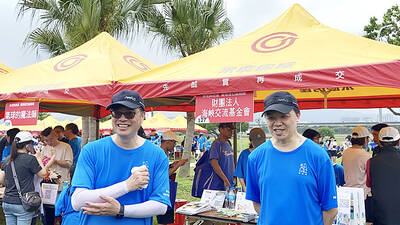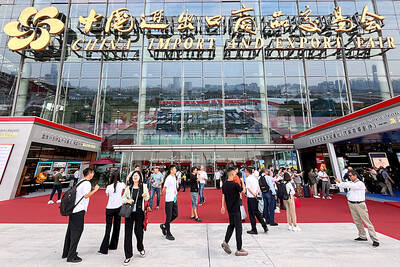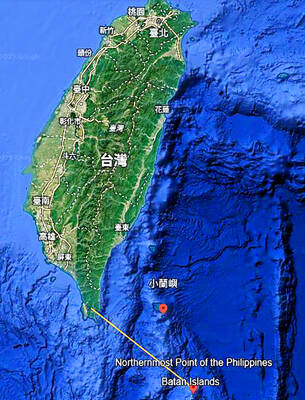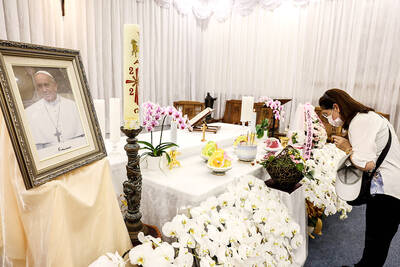Chinese Nationalist Party (KMT) politicians yesterday criticized the Ministry of Culture’s proposal to remove symbols related to Chiang Kai-shek (蔣介石) from the Chiang Kai-shek Memorial Hall, with Chiang’s great-grandson and KMT Legislator Chiang Wan-an (蔣萬安) saying the Democratic Progressive Party (DPP) government should present a “full picture” of Chiang Kai-shek, rather than just focusing on his misdeeds.
The real aim of the proposal is not to dispose of totems relating to Chiang Kai-shek or Sun Yat-sen (孫逸仙), but to negate the Republic of China (ROC), KMT Chairwoman Hung Hsiu-chu (洪秀柱) said.
She called the removal “unwise,” saying it would polarize society and incite social division and hatred.

Photo: Chien Jung-fong, Taipei Times
The DPP’s objective is ideological; it wants to “amplify the impact of historical tragedies at a particular time,” KMT Central Committee member Sean Lien (連勝文) said, adding that the nation has “more important things to do,” such as lowering the unemployment rate, solving the problem of low pay and improving cross-strait relations.
Calling the memorial hall an “important cultural resource” and a “major tourist attraction,” KMT Vice Chairman Hau Lung-bin (郝龍斌) said it is a favorite destination of many Chinese tourists and facilitates the promotion of Taiwan’s democracy, progress and economic development.
President Tsai Ing-wen’s (蔡英文) administration’s “inappropriate” proposal was made out of “ideological reasons,” he added.
Hau continued his criticism on Facebook, saying that the Tsai administration’s taking aim at the memorial hall reminded him of the way former president Chen Shui-bian (陳水扁), near the end of his term, tried to distract public attention from his poor performance by “messing around with” the hall.
Hau wrote that it was he, in his then-capacity as Taipei mayor, who had prevented the DPP’s “malicious ideological act.”
In 2007, Chen proposed changing the hall’s name to the “National Taiwan Democracy Memorial Hall,” but was stymied by the Taipei City Government, which regarded the architecture, the plaza, the archways and the walls as city-level “historical sites.”
Hau, who is running for KMT chairman, also talked of Chiang Kai-shek’s “contribution in leading the nationalist army to protect Taiwan.”
“Without the Aug. 23 Artillery Battle that successfully safeguarded Taiwan, whose flag would have been flying over Taiwan? Would it be the ROC flag or the five-star [People’s Republic of China] flag? Would Taiwan still have today’s democracy, freedom and openness? Maybe even the DPP would not have existed,” Hau wrote.
On Aug. 23, 1958, the People’s Republic of China launched an intense artillery bombardment on Kinmen as China attempted to seize Matsu and Kinmen from the ROC.
While it is expected that the government would take certain actions to commemorate the 70th anniversary of the 228 Incident this year, Taiwan should be able to rationally present a full picture consisting of both Chiang Kai-shek’s achievements and misdeeds, Chiang Wan-an said.
Perhaps only his achievements were saluted during the authoritarian era, but the present government would be repeating the mistakes of that era if it mentioned only Chiang Kai-shek’s errors, and did not recount history in an objective and ideology-free way, he said.
The lawmaker said that he agrees with the proposal to use historical materials that show Chiang Kai-shek’s achievements and his misdeeds, adding that Taiwanese should have the opportunity to make their own judgements about their shared memories.
Additional Reporting by CNA

SECURITY: As China is ‘reshaping’ Hong Kong’s population, Taiwan must raise the eligibility threshold for applications from Hong Kongers, Chiu Chui-cheng said When Hong Kong and Macau citizens apply for residency in Taiwan, it would be under a new category that includes a “national security observation period,” Mainland Affairs Council (MAC) Minister Chiu Chui-cheng (邱垂正) said yesterday. President William Lai (賴清德) on March 13 announced 17 strategies to counter China’s aggression toward Taiwan, including incorporating national security considerations into the review process for residency applications from Hong Kong and Macau citizens. The situation in Hong Kong is constantly changing, Chiu said to media yesterday on the sidelines of the Taipei Technology Run hosted by the Taipei Neihu Technology Park Development Association. With

CARROT AND STICK: While unrelenting in its military threats, China attracted nearly 40,000 Taiwanese to over 400 business events last year Nearly 40,000 Taiwanese last year joined industry events in China, such as conferences and trade fairs, supported by the Chinese government, a study showed yesterday, as Beijing ramps up a charm offensive toward Taipei alongside military pressure. China has long taken a carrot-and-stick approach to Taiwan, threatening it with the prospect of military action while reaching out to those it believes are amenable to Beijing’s point of view. Taiwanese security officials are wary of what they see as Beijing’s influence campaigns to sway public opinion after Taipei and Beijing gradually resumed travel links halted by the COVID-19 pandemic, but the scale of

A US Marine Corps regiment equipped with Naval Strike Missiles (NSM) is set to participate in the upcoming Balikatan 25 exercise in the Luzon Strait, marking the system’s first-ever deployment in the Philippines. US and Philippine officials have separately confirmed that the Navy Marine Expeditionary Ship Interdiction System (NMESIS) — the mobile launch platform for the Naval Strike Missile — would take part in the joint exercise. The missiles are being deployed to “a strategic first island chain chokepoint” in the waters between Taiwan proper and the Philippines, US-based Naval News reported. “The Luzon Strait and Bashi Channel represent a critical access

Pope Francis is be laid to rest on Saturday after lying in state for three days in St Peter’s Basilica, where the faithful are expected to flock to pay their respects to history’s first Latin American pontiff. The cardinals met yesterday in the Vatican’s synod hall to chart the next steps before a conclave begins to choose Francis’ successor, as condolences poured in from around the world. According to current norms, the conclave must begin between May 5 and 10. The cardinals set the funeral for Saturday at 10am in St Peter’s Square, to be celebrated by the dean of the College